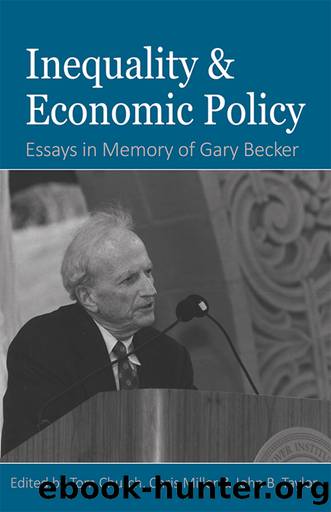Inequality and Economic Policy by Church Tom;Miller Chris;Taylor John B.;

Author:Church, Tom;Miller, Chris;Taylor, John B.; [Church, Tom]
Language: eng
Format: epub
Publisher: Hoover Institution Press
Published: 2015-08-15T00:00:00+00:00
FIGURE 6.1. Returns to college education, 1963â2012
Source: Based on previous work done by Katz and Murphy (1992) updated to 2012
The key feature on which you might focus is that there was a decline in the returns to college in the 1970s, which was actually a period where people were talking about Americans being overeducated. That was followed by the dramatic rise that occurred during the 1980s, a continued rise in the 1990s, and a relatively flat premium in the 2000s. What I hadnât really fully appreciated until the discussion over the last few days is that the timing of 1980 to 2000 as the big transition period is true for things beyond the college premium and wage inequality. A lot of the graphs that we saw the other day and a lot of the discussions that we heard yesterday on inequality at the top of the income distribution mirrored that same picture. A lot of what happened at the top of the income distribution happened pre-2000. Thatâs certainly the case here when we look at the returns to college.
The other thing to note is just how dramatic that change is. The early-human-capital literature of the 1960s talked about the 7 percent return. It actually fell to maybe 5 percent in the 1970s. That was the âovereducated Americaâ period. Now, you get returns more like 13 percent. Itâs really quite dramatic. Again, think about it in terms of prices. If you think about college as an investment, this would suggest that thereâs an enormous return to investment todayâroughly triple what is was in 1980. At the same time, think about this as a price from the point of view of driving inequality in terms of the outcomes. Itâs like when the price of oil goes up. All of the guys who have oil are much better off than they were before, and all of the people who need to buy gas are worse off than they were before. Thatâs part of the story. The other side is that thereâs a big incentive now to go out and to find more oil and to produce more oil than you did in the past. Thatâs going to be true in the college market as well.
Figure 6.2 gives the change in the log wage rate over a roughly forty-year period from 1970â72 to 2010â12 for men and women by percentile of the wage distribution. These are different people at the beginning and end, and Iâm matching the median in 1970 with the median in 2010. What we are asking is: how did the wages associated with different points in that distribution change over time? There are several interesting things about a figure like this, which will be part of the story when thinking about inequality.
One is to remember the timing. Itâs going up. Itâs not all the last ten years. Itâs been going up over time, but the other is that this is an upward-sloping line throughout the range. Thereâs a bigger increase at
Download
This site does not store any files on its server. We only index and link to content provided by other sites. Please contact the content providers to delete copyright contents if any and email us, we'll remove relevant links or contents immediately.
| Anthropology | Archaeology |
| Philosophy | Politics & Government |
| Social Sciences | Sociology |
| Women's Studies |
The Secret History by Donna Tartt(18246)
The Social Justice Warrior Handbook by Lisa De Pasquale(11965)
Thirteen Reasons Why by Jay Asher(8481)
This Is How You Lose Her by Junot Diaz(6466)
Weapons of Math Destruction by Cathy O'Neil(5864)
Zero to One by Peter Thiel(5512)
Beartown by Fredrik Backman(5375)
The Myth of the Strong Leader by Archie Brown(5252)
The Fire Next Time by James Baldwin(5035)
How Democracies Die by Steven Levitsky & Daniel Ziblatt(4973)
Promise Me, Dad by Joe Biden(4916)
Stone's Rules by Roger Stone(4876)
100 Deadly Skills by Clint Emerson(4705)
A Higher Loyalty: Truth, Lies, and Leadership by James Comey(4569)
Rise and Kill First by Ronen Bergman(4555)
Secrecy World by Jake Bernstein(4411)
The David Icke Guide to the Global Conspiracy (and how to end it) by David Icke(4403)
The Farm by Tom Rob Smith(4335)
The Doomsday Machine by Daniel Ellsberg(4255)
